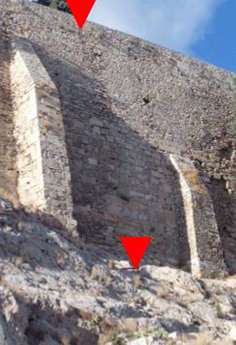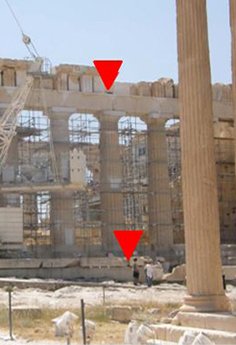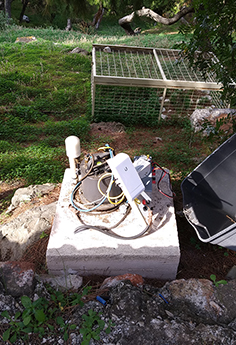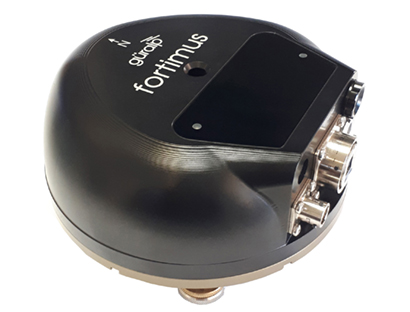Background
Since 2006 the National Observatory of Athens, Institute of Geodynamics (NOAIG) have been in cooperation with the Acropolis Restoration Service for the study of strong ground motion. In 2008, NOAIG undertook a project to upgrade and extend a strong motion array, which today consists of 11 Güralp 5TDE’s which are integrated digital accelerometers.
The Athenian Acropolis is the most outstanding of ancient Greek monumental complexes which still exists in our time. It stands proudly above the city of Athens at 150m above sea level with the first artefacts found dating back to the Neolithic period (6th millennium BC).
The Acropolis is a cliff consisting of two units, the Athens schist and the overlying Acropolis limestone. The Athens schist is a soft reddish rock dating from the upper Cretaceous. The original sediments were deposited in a river delta approximately 70 million years ago. The Acropolis limestone dates from the upper Jurassic period, predating the underlying Athens schist by 30 million years. The Acropolis limestone was thrust over the Athens schist by compressional tectonic forces, forming an overthrust sheet. Erosion of the limestone nappe led to the eventual detachment of the Acropolis, forming the present day feature. The marble utilized to construct the buildings of the Acropolis was sourced from the quarries of Mount Pentelicus, a mountain to the northeast of the city.
In 1986 The Acropolis was included within the UNESCO list as a World Heritage Site demonstrating its importance in the history of the modern world.
The Acropolis site is a complex of different monuments, each of which has its own characteristics. Restorations to its structures have been taking place since Otto’s rule (1833). These, along with other human activities such as wars when the Acropolis has been used as a fort, plus natural events such as earthquakes and material weathering have all had an effect on the monuments and the Acropolis as a whole. So in 2006 it was decided that monitoring of the physical parameters of the Acropolis and its monuments was crucial to its successful conservation.
The Athenian Acropolis is the most outstanding of ancient Greek monumental complexes which still exists in our time. It stands proudly above the city of Athens at 150m above sea level with the first artefacts found dating back to the Neolithic period (6th millennium BC).
The Acropolis is a cliff consisting of two units, the Athens schist and the overlying Acropolis limestone. The Athens schist is a soft reddish rock dating from the upper Cretaceous. The original sediments were deposited in a river delta approximately 70 million years ago. The Acropolis limestone dates from the upper Jurassic period, predating the underlying Athens schist by 30 million years. The Acropolis limestone was thrust over the Athens schist by compressional tectonic forces, forming an overthrust sheet. Erosion of the limestone nappe led to the eventual detachment of the Acropolis, forming the present day feature. The marble utilized to construct the buildings of the Acropolis was sourced from the quarries of Mount Pentelicus, a mountain to the northeast of the city.
In 1986 The Acropolis was included within the UNESCO list as a World Heritage Site demonstrating its importance in the history of the modern world.
The Acropolis site is a complex of different monuments, each of which has its own characteristics. Restorations to its structures have been taking place since Otto’s rule (1833). These, along with other human activities such as wars when the Acropolis has been used as a fort, plus natural events such as earthquakes and material weathering have all had an effect on the monuments and the Acropolis as a whole. So in 2006 it was decided that monitoring of the physical parameters of the Acropolis and its monuments was crucial to its successful conservation.
Network design and deployment
5TDE Broadband Accelerometers
The Güralp 5TDE* is an integrated accelerometer with on board memory and has the capability to transfer data both over Ethernet and via Wi-Fi.
The Acropolis array consists of 11 5TDE instruments transmitting data continuously and in real time to NOAIG using wi-fi technology.
The 5TDE’s are positioned at strategic points to measure movements generated by both restoration works and seismicity in relation to the effect on the Acropolis and its monuments.
Each 5TDE is installed on small, specifically constructed vaults with concrete piers at sites selected to cover the broader hill and the monuments under investigation. This includes at the base and top of structures such as walls and pillars.
The Acropolis array consists of 11 5TDE instruments transmitting data continuously and in real time to NOAIG using wi-fi technology.
The 5TDE’s are positioned at strategic points to measure movements generated by both restoration works and seismicity in relation to the effect on the Acropolis and its monuments.
Each 5TDE is installed on small, specifically constructed vaults with concrete piers at sites selected to cover the broader hill and the monuments under investigation. This includes at the base and top of structures such as walls and pillars.




5TDE accelerometers are located at the base and on the top of walls and piers
Vault for the 5TDE with plinth made of concrete for improved coupling and Wi-Fi extender
Completed station with housing
Outcome
Since the installation of the array in 2008, the 5TDEs have successfully recorded more than 1000 seismic events. The data shows the variations in the response of each instrument depending on where they are located, for example, amplification of the ambient noise where they are sited in loose deposits and attenuation of the ambient noise where they are located on the limestone.
Events recorded include small local earthquakes, large regional earthquakes and even tele-seismic events such as the Nepal earthquake of 25 April, 2015 with an epicentre more than 6500 km from Athens.
Events recorded include small local earthquakes, large regional earthquakes and even tele-seismic events such as the Nepal earthquake of 25 April, 2015 with an epicentre more than 6500 km from Athens.
*The 5TDE instrument has been superceded by the Fortimus which is integrated with the Minimus digitiser and features flexible gain options, advanced data communications capabilities and an ultra-low-latency data transmission mode, ideal for early warning applications.
You can find out more about the Fortimus here.
You can find out more about the Fortimus here.
References
Dr. Ioannis Kalogeras, Seismologist – Research Director, Institute of Geodynamics, National Observatory of Athens – presentation to ORFEUS, 2018 ‘An excursion at the archaeological site of the Athenian Acropolis within the frame of Seismology’





